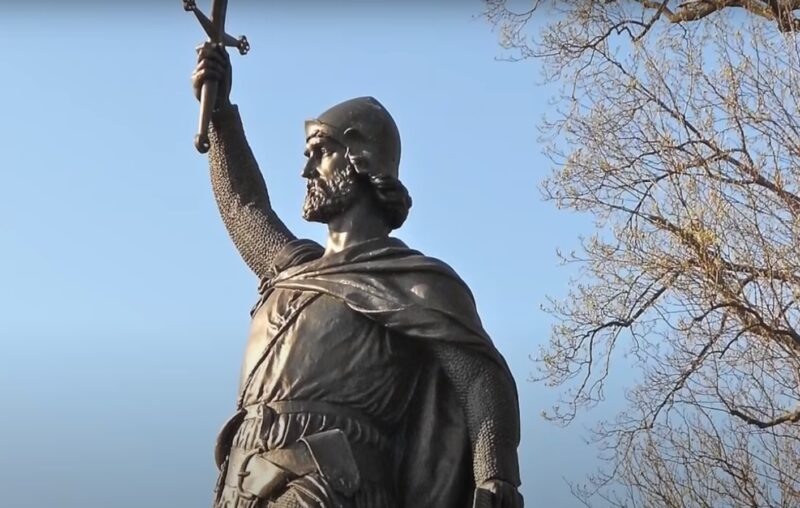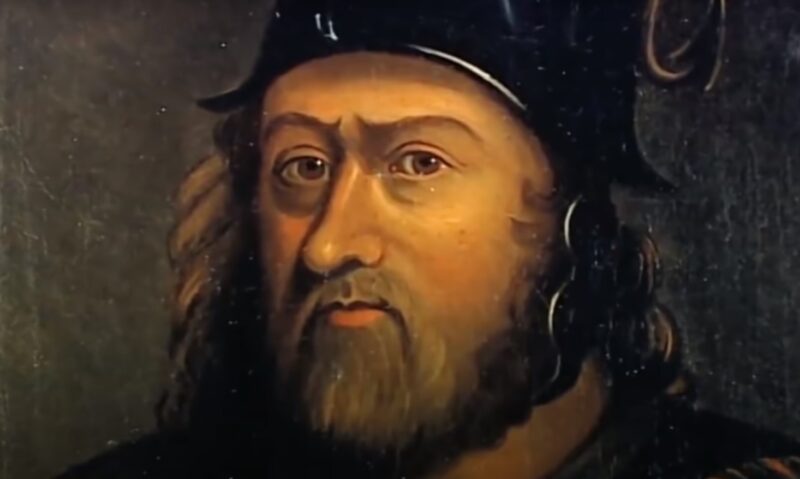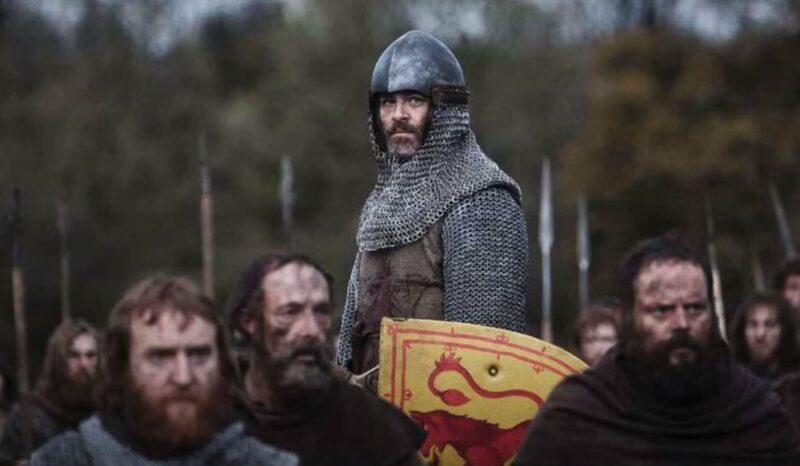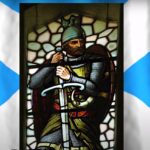William Wallace, a name synonymous with Scottish resistance against English domination in the late 13th and early 14th centuries, remains an enigmatic and heroic figure in history.
His life, culminating in a dramatic and tragic death, has been the subject of numerous books, films, and scholarly debates.
Today, we will explore the circumstances surrounding the death of William Wallace, presenting the known historical facts, the implications of his demise, and the legacy that followed.
The Capture and Trial
William Wallace’s rebellion against English rule in Scotland, marked by his victory at the Battle of Stirling Bridge in 1297 and his defeat at the Battle of Falkirk in 1298, was a significant chapter in the Wars of Scottish Independence.
By 1305, however, William’s situation had grown increasingly precarious. His support had waned, and he found himself isolated in his struggle against King Edward I of England.
Betrayal and Capture
Wallace’s capture was a result of betrayal. In August 1305, Sir John de Menteith, a Scottish knight loyal to Edward I, apprehended William near Glasgow.
The exact circumstances of the betrayal remain debated among historians, but it was a pivotal moment that led to Wallace’s downfall.
The capture of such a prominent figure was a substantial victory for Edward I, furthering his control over Scotland.
The Trial in London
William was transported to London, where he was put on trial for treason and crimes against civilians in war. The trial, held at Westminster Hall, was a highly publicized event.
William, refusing to acknowledge the authority of the court, famously declared, “I could not be a traitor to Edward, for I was never his subject.”
Despite his defiance, the outcome of the trial was a foregone conclusion.
The Execution of William Wallace
On August 23, 1305, William Wallace was executed. The manner of his execution was designed to be a public spectacle and a warning to other would-be rebels.
He was hanged, drawn, and quartered – a brutal method reserved for those deemed traitors. This execution involved hanging, but not to the point of death, followed by disembowelment and beheading.
His dismembered body was displayed in parts across England and Scotland as a grim reminder of the consequences of defying the crown.
The Impact of the Execution
William’s execution had a profound impact on both Scotland and England. In Scotland, it fueled the fires of resistance and became a rallying point for those opposing English rule.
In England, it was intended to quash the Scottish rebellion but ultimately had the opposite effect.
William’s martyrdom only strengthened Scottish resolve, leading to further uprisings and eventually to Scottish independence under Robert the Bruce.
The Symbolism of His Death
The manner and impact of Wallace’s death transformed him into a symbol of freedom and resistance against oppression.
His execution was not just the end of a man but the birth of a legend, inspiring future generations to fight for their rights and freedom.
The Legacy of William Wallace

After Wallace’s death, the struggle for Scottish independence continued, gaining momentum under the leadership of Robert the Bruce.
The legacy of William’s resistance played a significant role in shaping the national identity of Scotland and its quest for self-governance.
Historical Memory
William Wallace’s life and death have been romanticized and mythologized over the centuries. He has been the subject of numerous literary and artistic works, most notably in the epic poem “The Wallace” by the 15th-century minstrel Blind Harry.
In modern times, Wallace’s story reached a global audience through the 1995 film “Braveheart,” although the film took considerable liberties with historical facts.
The Significance in Modern Scotland
Today, William Wallace holds a place of honor in Scottish history. Monuments, such as the Wallace Monument in Stirling, stand as testaments to his enduring legacy.
He symbolizes the struggle for freedom and the resilience of the Scottish spirit. His story continues to inspire and resonate with people around the world who value liberty and fight against tyranny.
The Man and the Myth

Knowing William Wallace’s death also involves digging into the mythos that surround him. Over the centuries, he has become a larger-than-life figure, a symbol of Scottish nationalism and freedom.
The Historical William Wallace
Historically, William was a landowner and a knight. However, unlike the image often portrayed in popular media, he was likely not of noble birth.
Wallace rose to prominence through his military acumen and his ability to inspire and lead men in battle against a much more powerful adversary.
The Historical Context of Wallace’s Struggle
To fully appreciate the significance of Wallace’s life and death, it is crucial to understand the historical context in which he operated.
Scotland’s Struggle for Independence
During Wallace’s time, Scotland was fighting for independence from English rule. The death of King Alexander III in 1286 without a direct heir led to a power vacuum, with several claimants vying for the Scottish throne.
This situation was exploited by King Edward I of England, who sought to bring Scotland under his control.
The Wars of Scottish Independence
Wallace’s life was deeply intertwined with the First War of Scottish Independence. His actions were a direct response to the increasing English influence and dominance in Scotland.
The war was not just a battle for territory but also for the right to self-determination and national identity.
The Role of Nobility and Commoners
In Wallace’s campaign, there was a notable involvement of both the nobility and commoners. This alliance of different social classes was significant in the context of medieval warfare and politics.
Wallace’s ability to unite these diverse groups under a common cause was one of his remarkable achievements.
Reflections on Wallace’s Execution and Its Aftermath

Wallace’s execution was not only a moment of profound tragedy but also a catalyst for significant historical developments.
Immediate Reactions to the Execution
The immediate reaction in Scotland to Wallace’s execution was one of outrage and mourning. It strengthened the resolve of the Scots to continue their struggle against English rule.
Wallace’s death became a symbol of martyrdom, galvanizing support for the Scottish cause.
Long-Term Historical Implications
In the long term, Wallace’s execution had significant implications for the Wars of Scottish Independence. It brought to the forefront the brutality of English rule and the legitimacy of the Scottish struggle for freedom.
This event played a crucial role in shaping the national identity of Scotland.
The Transformation of Scottish Leadership
After Wallace’s death, leadership of the Scottish resistance passed to other figures, most notably Robert the Bruce.
The nature of the struggle changed, becoming more organized and ultimately leading to significant victories like the Battle of Bannockburn in 1314.
FAQs
What was Wallace’s Cause of Death?
He was executed on August 23, 1305. His cause of death was execution by hanging, drawing, and quartering, a method reserved for those convicted of high treason.
This brutal form of execution was intended to serve as a public spectacle and a warning against rebellion.
What Made William Wallace a Hero?
He is celebrated as a hero primarily for his role in leading the Scottish resistance against English rule during the Wars of Scottish Independence.
His military leadership, particularly at the Battle of Stirling Bridge, and his unwavering commitment to Scottish independence earned him a place as a national hero in Scotland.
What Problems Did William Wallace Face?
He faced numerous challenges, including the overwhelming military might of England under King Edward I, internal divisions within Scotland, and a lack of sustained support from the Scottish nobility.
His struggle also involved countering the strategies of a well-equipped and experienced English army.
What was William Wallace’s Goal?
His primary goal was the independence of Scotland from English rule. He sought to free Scotland from the domination of King Edward I of England and to restore a sense of national sovereignty and self-governance to the Scottish people.
What Did ‘Braveheart’ Get Wrong?
The film ‘Braveheart’ took significant liberties with historical facts. It inaccurately portrayed Wallace’s origins, relationships, and several key events.
For instance, the film’s depiction of the Battle of Falkirk, Wallace’s romantic involvement with Princess Isabella of France, and his portrayal as a high-born noble are all historically inaccurate.
Did William Wallace Have a Child?
There is no reliable historical evidence to suggest that he had any children. Much of his personal life remains a mystery, and any claims about his having descendants are speculative and not supported by concrete historical records.
Was William Wallace a Peasant?
No, he was not a peasant. He was a member of the lesser nobility. He owned some land and had a background that allowed him to be educated and emerge as a military leader and spoke English, French, Gaelic, and Latin.
The notion of him being a peasant likely stems from popular representations that seek to amplify his role as a symbol of the common man’s struggle against oppression.
Closing Thoughts
William Wallace’s death was more than just the execution of a man; it was an event that shaped the course of Scottish and British history. His life and death resonate through the ages as a testament to the power of individual courage against overwhelming odds.
Wallace’s legacy is not just in the details of his demise but in the enduring spirit of resistance and the pursuit of freedom that he epitomized.
His story, steeped in both fact and legend, continues to captivate and inspire, reminding us of the enduring human quest for liberty and justice.






